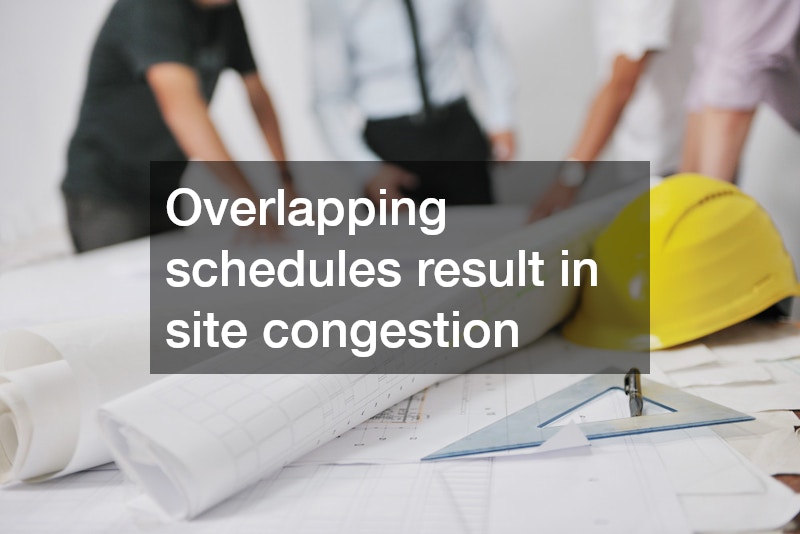Key takeaways:
-
Use detailed scheduling tools and real-time adjustments to maintain momentum.
-
Plan around weather risks with smart sequencing and weather-adapted equipment rentals.
-
Coordinate deliveries and equipment—especially cranes and lifts—well in advance.
-
Vet labor partners thoroughly and back them up with workforce tracking systems.
-
Minimize changes mid-project with strong client communication and digital change order workflows.

Construction delays are a significant threat to profitability, reputation, and client satisfaction. When a timeline stretches beyond expectations, it increases costs for labor, materials, equipment rentals, permits, insurance, and sometimes even legal settlements. Delays may also lead to strained relationships with owners, investors, or tenants, and in worst cases, result in the loss of future contracts.
While weather events and unforeseen circumstances are sometimes unavoidable, the majority of construction delays are preventable with careful coordination, early planning, and strategic use of resources. This article explores the five most common causes of construction delays—and offers in-depth, practical strategies to avoid them. Whether you’re managing commercial, residential, or infrastructure projects, these insights are tailored for construction businesses that want to stay ahead of schedule and under budget.
1. Poor Project Planning and Scheduling
Inadequate planning is one of the most common and costly sources of delay in construction. When critical details are overlooked in the early phases, the result is confusion in the field, inefficient resource use, trade overlaps, and frequent rework.
Key consequences:
-
Workers and equipment show up before tasks are ready, creating expensive downtime.
-
Overlapping schedules result in site congestion, safety hazards, and miscommunication.
-
Trade sequencing errors delay dependent tasks, causing cascading effects.
Prevention strategies:
-
Use advanced scheduling software:
Leverage platforms like Primavera P6, Microsoft Project, or Procore to create granular schedules with task dependencies, durations, and resource allocations. -
Define a clear critical path:
Map out the chain of tasks that directly affects the project’s completion date to identify where even a one-day delay will cause ripple effects. -
Hold pre-construction coordination meetings:
Get input from engineers, subcontractors, crane rental providers, utility crews, and site managers to ensure the plan is executable in real-world conditions. -
Include time contingencies in the schedule:
Build buffers between trade handoffs and weather-sensitive activities to absorb small setbacks without pushing the whole timeline. -
Assign a dedicated scheduler or project controller:
This role is essential for updating the schedule in real time, adjusting sequences based on progress, and communicating changes across teams.
2. Weather and Site Conditions
Weather-related delays can severely impact construction timelines—especially on exterior or vertical builds. Rain, wind, snow, and extreme heat or cold can slow or halt operations, especially those involving cranes, roof work, or concrete pours. Poor site conditions such as muddy terrain or flooding can also restrict equipment movement and delay foundation work.
Real-world examples:
-
A crane lift postponed due to high wind speeds, requiring re-mobilization.
-
Concrete pours delayed by cold weather, affecting structural framing.
-
Excavation halted due to waterlogged soil, pushing back subsequent trades.
Prevention strategies:
-
Consult historical weather data:
Use climate modeling tools to identify likely weather patterns in your region and schedule accordingly. -
Rent weather-adapted equipment:
-
Rough-terrain cranes and forklifts provide mobility on muddy or uneven sites.
-
Enclosed boom lifts allow crews to work at height during cold or windy days.
-
Portable heaters and curing blankets help maintain concrete integrity in cold conditions.
-
-
Implement site drainage and protections:
-
Temporary grading and gravel roads prevent washouts and muddy delays.
-
Water pumps and trench covers reduce downtime caused by flooding.
-
Tents and weather shelters allow interior finishes or inspections to proceed in bad weather.
-
-
Sequence high-risk activities for ideal windows:
Plan for roofing, exterior painting, or structural lifts during historically dry seasons to reduce risk of costly rescheduling.
3. Late Equipment or Material Deliveries
Few things stall a project more than a delayed delivery of essential materials or equipment. These issues often affect high-cost phases such as steel erection, mechanical installs, and façade assembly. In many cases, a crane and crew are scheduled—but if the material isn’t on-site, the entire lift is wasted.
Root causes:
-
Poor communication between suppliers and project teams
-
Incomplete submittals or approvals holding up orders
-
Traffic, customs, or supplier backlogs
-
Rental equipment not scheduled in time
Prevention strategies:
-
Coordinate and confirm delivery dates with suppliers early:
For long-lead items like structural steel, curtain walls, and prefabricated MEP modules, secure delivery windows months in advance. -
Develop a detailed delivery schedule:
-
Include drop-off times, access points, and equipment needed for offloading.
-
Coordinate closely with crane rental companies so lifting crews and equipment are on-site when needed.
-
-
Schedule critical equipment rentals ahead of time:
Equipment delays can paralyze productivity. Here’s how to manage the most vital rentals:
Cranes
-
Book cranes (tower, mobile, or rough-terrain) well in advance of major structural phases.
-
Ensure the rental company provides a certified operator, lift plan, and onsite assistance.
-
Factor in setup time, transport, and potential re-mobilization if weather causes cancellations.
Excavators
-
Needed early for site clearing, trenching, and grading.
-
Choose the appropriate size based on project scale to avoid underpowered or oversized equipment inefficiencies.
Skid Steers and Loaders
-
Essential for moving debris, unloading materials, and preparing flatwork.
-
Keep at least one on-site throughout framing and mechanical installations.
Aerial Work Platforms
-
Scissor lifts and boom lifts are critical for safe, efficient work at heights.
-
Delay in rental means idle electrical, HVAC, or façade crews.
Telehandlers and Forklifts
-
Required for palletized material handling and upper-floor placement.
-
Choose models based on lifting height, reach, and load capacity.
-
-
Use software to track deliveries:
Real-time dashboards help verify where shipments are, identify delays early, and allow for quick rescheduling or reallocation. -
Maintain a secondary supplier list:
Prequalify alternate vendors for key materials or equipment so that you can pivot quickly if your primary source has issues.
4. Labor Shortages and Subcontractor No-Shows
Skilled labor availability continues to be one of the biggest industry challenges. Whether it’s due to a tight market, absenteeism, or overbooked subcontractors, an under-resourced site can’t meet its productivity targets—no matter how well materials and equipment are scheduled.
Common labor-related setbacks:
-
Entire crews missing due to overcommitments or poor management.
-
Work done out of sequence due to unavailable specialists.
-
Safety violations or rework caused by poorly trained workers.
Prevention strategies:
-
Prequalify subcontractors thoroughly:
-
Verify their active project load and workforce capacity.
-
Review past performance on schedule adherence, safety, and coordination.
-
-
Draft clear contractual expectations:
-
Include milestone requirements, daily minimum crew sizes, and penalties for no-shows.
-
Require daily progress reporting and attendance verification.
-
-
Build in redundancy:
-
Keep a roster of vetted alternative subcontractors and temporary labor services.
-
Cross-train internal staff to fill temporary gaps in key roles.
-
-
Use workforce management tools:
-
Platforms like Raken, PlanGrid, or Fieldwire allow you to track crew productivity, check in/out times, and task completion rates.
-
Use data to forecast labor needs and identify problem trades early.
-
-
Offer retention incentives and continuous training:
Skilled labor is a valuable asset. Treating workers as long-term partners rather than disposable resources reduces turnover and builds trust.
5. Change Orders and Scope Creep
Few things derail timelines faster than unexpected changes mid-project. These can range from small design modifications to major structural revisions—and each one has downstream effects on procurement, labor, inspections, and project sequencing.
Typical sources of change orders:
-
Client requests or indecision
-
Incomplete drawings or engineering errors
-
Missed code requirements
-
Material unavailability requiring substitutions
Prevention strategies:
-
Clarify project scope upfront:
-
Develop a comprehensive preconstruction package with detailed drawings, specs, and materials lists.
-
Walk the client through all finishes, layouts, and options to minimize post-launch revisions.
-
-
Create a formal change order process:
-
Use digital project management systems (e.g., Buildertrend, Procore) for fast documentation, sign-offs, and distribution.
-
Assign a change order coordinator or estimator to handle impact analysis and pricing.
-
-
Track the schedule impact of every change:
-
Recalculate delivery dates, crane lifts, trade sequencing, and inspections as soon as a change is approved.
-
Reconfirm with rental providers (especially crane operators) if changes affect heavy equipment schedules.
-
-
Set client expectations early:
-
Make it clear that late-stage changes will impact cost and time.
-
Offer minor flexibility for finish upgrades, but resist frequent structural or system redesigns once construction begins.
-

Bonus: Lean and Agile Jobsite Practices
Incorporating lean and agile construction principles enhances your ability to avoid or adapt to delays. These systems focus on coordination, waste reduction, and iterative improvement.
Lean construction practices:
-
Just-in-time delivery: Avoids clutter and storage issues while aligning with task schedules.
-
Modular/prefabricated construction: Reduces on-site work and exposure to delays caused by weather or trade conflicts.
-
Pull planning: Backward scheduling based on when downstream teams need a task completed for theirs to begin.
Agile field management:
-
Daily crew huddles: Identify issues early, adjust workflows, and boost accountability.
-
Short feedback loops: Use real-time reporting to shift resources before problems escalate.
-
Visual planning boards: Help trades track task dependencies and adjust in the field as needed.
Prevent Delays with Planning, Coordination, and the Right Equipment
Construction delays aren’t just inconvenient—they’re expensive. But most of them can be avoided by focusing on upstream planning, proactive coordination, and strategic resourcing. From scheduling crane rentals early to confirming material deliveries and keeping crews aligned, every action you take before problems arise adds resilience to your project.

